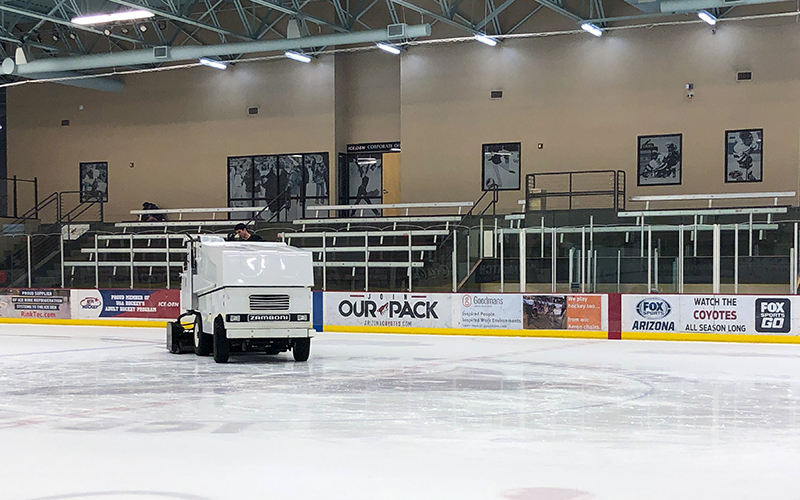The temperature in an NHL hockey arena is usually between 60-65°F. On the ice, it can drop to around 24°F.
Hockey fans often wonder just how cold it gets inside an NHL arena. Whether you’re attending a game or just curious, knowing the temperature can help you prepare. Ice rinks need to be cold to maintain the ice quality, which is crucial for the game.
This chill can be quite a shock if you’re not dressed for it. But why is the temperature kept so low? And how does it impact the game and the fans? Let’s dive deeper into the cold world of NHL hockey arenas and find out what to expect.

Credit: cronkitenews.azpbs.org
Typical Arena Temperature
Have you ever wondered how cold it is in an NHL hockey arena? The typical arena temperature is something many fans and players alike are curious about. It’s not just about comfort; the ice quality depends on it too. Let’s explore the standard range and factors affecting the temperature in these arenas.
Standard Range
The standard range for an NHL hockey arena is usually between 60 and 65 degrees Fahrenheit. This range ensures that the ice remains solid and safe for players. It also keeps the spectators comfortable. This temperature is cooler than room temperature but warmer than the ice itself.
Maintaining this range is crucial. Too warm, and the ice melts. Too cold, and the ice becomes too hard. Both conditions can make the game difficult to play and enjoy.
Factors Affecting Temperature
Several factors can affect the temperature in a hockey arena. One major factor is the number of spectators. More people generate more body heat. This can raise the temperature inside the arena. Engineers have to adjust the cooling systems to keep the temperature stable.
Another factor is the outside weather. Cold weather outside helps keep the arena cool. Hot weather requires more effort to maintain the right temperature inside. The arena’s insulation also plays a role. Good insulation helps maintain a consistent temperature.
The type of cooling system used is also important. Modern systems can better control the temperature. They ensure the ice stays perfect for the game. The technology behind these systems is quite advanced. It includes sensors and automatic adjustments.
In summary, the typical temperature in an NHL arena is carefully controlled. It involves a balance of many factors. This ensures a great experience for both players and fans.

Credit: www.rsi.edu
Impact On Players
The temperature inside an NHL hockey arena can impact players in several ways. Understanding these effects helps in appreciating the efforts of these athletes. Let’s dive into how the cold environment affects their performance and injury prevention.
Performance
Cold temperatures can significantly affect player performance. The ice needs to be well-maintained for a fast and smooth game. A typical NHL arena is kept at around 60-65°F (15-18°C). This cool environment helps maintain the ice quality.
For players, the cold can be both a challenge and an advantage. Muscles need to stay warm to perform optimally. Teams use heated benches to help players stay warm during breaks. The cold air can also help players stay alert and focused. However, it requires more energy to keep the body warm, which can lead to fatigue.
Injury Prevention
Cold environments can increase the risk of injury. Muscles and joints are stiffer and less flexible in the cold. Players need to spend extra time warming up before games. Proper stretching and movement exercises are crucial. This helps in preventing strains and sprains.
Protective gear is another important factor. Players wear padded clothing which provides warmth and protection. Helmets, gloves, and pads are all designed to keep the body warm. They also prevent injuries from falls and hits.
Teams invest in the best medical staff to care for players. Physiotherapists and doctors ensure players are in top condition. They monitor for signs of cold-related injuries and fatigue. This helps in keeping players safe and healthy throughout the game.
Fan Comfort
Fan comfort is essential when attending a NHL hockey game. The arena’s temperature can affect your overall experience. Understanding how to stay comfortable in the cold environment is crucial.
Dressing Appropriately
Layering is key. Wear a thermal shirt under your jersey. Bring a hoodie or a jacket. Don’t forget a warm hat and gloves. Your hands and head lose heat quickly.
Comfortable, warm shoes are also important. Cold feet can make you miserable. Thick socks can help keep your feet warm. Avoid shoes with thin soles.
Staying Warm
Holding a hot beverage can warm your hands. Coffee, hot chocolate, or tea are good options. A warm drink can also help keep your core temperature up.
Consider bringing a small, portable blanket. You can wrap it around your legs. This adds an extra layer of warmth. Be sure it’s allowed in the arena first.
Take breaks and walk around during intermissions. Movement can help keep your blood flowing. This can make you feel warmer. Remember, staying active helps combat the cold.

Credit: rinkresult.com
Ice Maintenance
Maintaining the ice in an NHL hockey arena is crucial. The ice must be perfect for the fast-paced game. But how is this achieved? Let’s explore the key aspects of ice maintenance.
Ice Quality
Ice quality is paramount for a smooth game. The ice must be hard and clear. Soft or slushy ice can slow players down. It can also increase the risk of injuries. The ice is made by layering thin sheets of water. Each layer freezes before the next one is added. This process ensures the ice is solid and uniform.
Temperature Control
Temperature control is critical in maintaining good ice. The arena’s temperature must be kept just right. The ice surface is usually around 24-26°F (-4 to -3°C). The air temperature is slightly warmer, around 50-60°F (10-15°C). This balance ensures the ice stays frozen but not too hard. The right temperature helps players glide smoothly.
Technological Advances
Modern NHL hockey arenas have seen significant technological advances. These innovations ensure the ice remains perfect for games. They also make the experience more comfortable for fans. Two key areas of progress are climate control systems and energy efficiency.
Climate Control Systems
Climate control systems in NHL arenas have improved greatly. They keep the temperature just right for players and fans. Advanced sensors monitor the environment. They adjust temperatures to maintain optimal conditions. This ensures the ice stays frozen and the air stays cool.
Energy Efficiency
Energy efficiency is also crucial in NHL arenas. Modern systems use less power while maintaining ice quality. LED lighting and efficient HVAC systems help reduce energy consumption. This makes the arena more environmentally friendly. It also helps save on operational costs.
Frequently Asked Questions
How Cold Is It Inside An Nhl Hockey Arena?
Inside an NHL hockey arena, temperatures usually range from 60°F to 65°F.
Why Is It Cold In An Nhl Hockey Arena?
The ice needs to stay frozen for the game. Hence, the arena is kept cold.
Do You Need A Jacket In A Hockey Arena?
Yes, wearing a jacket or sweater is recommended to stay warm.
Can The Cold Affect Players’ Performance?
Yes, cold can affect grip and muscle performance. Players often wear layers.
How Do Fans Stay Warm In A Hockey Arena?
Fans can stay warm by wearing layers, hats, and gloves.
Is It Colder Near The Ice In A Hockey Arena?
Yes, it is colder near the ice due to the direct contact with the frozen surface.
What Should I Wear To An Nhl Game?
Comfortable, warm clothing like jackets, sweaters, and hats are best.
How Is The Ice Kept Frozen In A Hockey Arena?
A complex refrigeration system keeps the ice frozen at optimal conditions.
Can The Cold In An Arena Cause Health Issues?
Prolonged exposure to cold can cause discomfort. Dressing warmly helps prevent issues.
Conclusion
Hockey arenas are colder than most places. Dress warmly to stay comfortable. The ice needs low temperatures to stay frozen. Layers help you adjust to the cold. Bring gloves and a hat too. This ensures you enjoy the game without feeling chilly.
Understanding the arena’s temperature helps you prepare better. Enjoy your time watching hockey!




